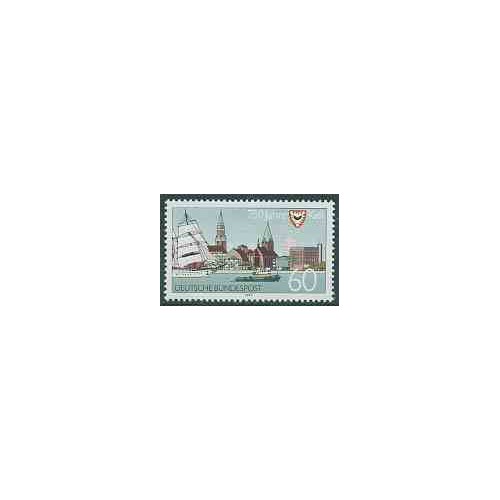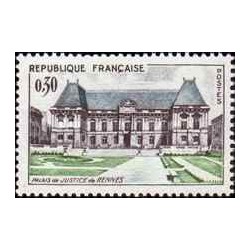- جدید
- ناموجود



Germany, Federal Republic 1992 - 750 years Kiel 1v
توجه : درج کد پستی و شماره تلفن همراه و ثابت جهت ارسال مرسوله الزامیست .
توجه:حداقل ارزش بسته سفارش شده بدون هزینه پستی می بایست 100000 ریال باشد.
کیل(به آلمانی: Kiel) (![]() [ki:l] راهنما·اطلاعات) مرکز و پرجمیعتترین شهر ایالت اشلسویگ-هولشتاین آلمان با ۲۳۶٬۰۰۰ نفر جمعیت است.
[ki:l] راهنما·اطلاعات) مرکز و پرجمیعتترین شهر ایالت اشلسویگ-هولشتاین آلمان با ۲۳۶٬۰۰۰ نفر جمعیت است.
این شهر حدوداً در ۹۰ کیلومتری هامبورگ قرار دارد. این شهر شهری بندری بوده و دریانوردی در آن رونق دارد.[۱]
Kiel (German pronunciation: [ˈkiːl] (![]() listen)) is the capital and most populous city in the northern German state of Schleswig-Holstein, with a population of 240,832 (June 2014).
listen)) is the capital and most populous city in the northern German state of Schleswig-Holstein, with a population of 240,832 (June 2014).
Kiel lies approximately 90 kilometres (56 mi) north of Hamburg. Due to its geographic location in the north of Germany, the southeast of the Jutland peninsula, and the southwestern shore of the Baltic Sea, Kiel has become one of the major maritime centres of Germany. For instance, the city is known for a variety of international sailing events, including the annual Kiel Week, which is the biggest sailing event in the world. The Olympic sailing competitions of the 1936 and the 1972 Summer Olympics were held in Kiel.[3]
Kiel has also been one of the traditional homes of the German Navy's Baltic fleet, and continues to be a major high-tech shipbuilding centre. Located in Kiel is the GEOMAR Helmholtz Centre for Ocean Research Kiel (GEOMAR) at the University of Kiel. Kiel is an important sea transport hub, thanks to its location on the Kiel Fjord (Kieler Förde) and the busiest artificial waterway in the world, Kiel Canal (Nord-Ostsee-Kanal). A number of passenger ferries to Sweden, Norway, Russia, and other countries operate from here. Moreover, today Kiel harbour is an important port of call for cruise ships touring the Baltic Sea.
In 2005 Kiel's GDP per capita was €35,618, which is well above Germany's national average, and 159% of the European Union's average.[4]
Within Germany and parts of Europe, the city is known for its leading handball team, THW Kiel. The city is home to the University of Kiel (established in 1665).
The name of the city is most likely derived from the wedge form of its bay (Keil in German).[5]
Kiel Fjord was probably first settled by Normans or Vikings who wanted to colonize the land which they had raided, and for many years they settled in German villages. This is evidenced by the geography and architecture of the fjord. The city of Kiel was originally founded in 1233 as Holstenstadt tom Kyle by Count Adolf IV of Holstein, and granted Lübeck city rights in 1242 by Adolf's eldest son, John I of Schauenburg. Being a part of Holstein, Kiel belonged to the Holy Roman Empire and was situated only a few miles south of the Danish border.[6]
Kiel, the capital of the county (later duchy) of Holstein, was a member of the Hanseatic League from 1284 until it was expelled in 1518 for harbouring pirates. In 1431, the Kieler Umschlag (trade fair) was first held, which became the central market for goods and money in Schleswig-Holstein, until it began to lose significance from 1850 on, being held for the last time in 1900, until recently, when it has been restarted.
The University of Kiel was founded on 29 September 1665, by Christian Albert, Duke of Holstein-Gottorp. A number of important scholars, including Theodor Mommsen and Max Planck, studied or taught there.
From 1773 to 1864, the town belonged to the King of Denmark. However, because the king ruled Holstein as a fief of the Holy Roman Empire only through a personal union, the town was not incorporated as part of Denmark proper. Thus Kiel belonged to Germany, but it was ruled by the Danish king. Even though the Empire was abolished in 1806, the Danish king continued to rule Kiel only through his position as Duke of Holstein, which became a member of the German Confederation in 1815. When Schleswig and Holstein rebelled against Denmark in 1848 (the First Schleswig War), Kiel became the capital of Schleswig-Holstein until the Danish victory in 1850.
During the Second Schleswig War in 1864, Kiel and the rest of the duchies of Schleswig and Holstein were conquered by a German Confederation alliance of the Austrian Empire and the Kingdom of Prussia. After the war, Kiel was briefly administered by both the Austrians and the Prussians, but the Austro-Prussian War in 1866 led to the formation of the Province of Schleswig-Holstein and the annexation of Kiel by Prussia in 1867. On 24 March 1865 King William I based Prussia's Baltic Sea fleet in Kiel instead of Danzig (Gdańsk).
When William I of Prussia became Emperor William I of the German Empire in 1871, he designated Kiel and Wilhelmshaven as Reichskriegshäfen ("Imperial War Harbours"). The prestigious Kiel Yacht Club was established in 1887 with Prince Henry of Prussia as its patron. Emperor Wilhelm II became its commodore in 1891.
Because of its new role as Germany's main naval base, Kiel very quickly increased in size in the following years, from 18,770 in 1864 to about 200,000 in 1910. Much of the old town centre and other surroundings were levelled and redeveloped to provide for the growing city. The Kiel tramway network, opened in 1881, had been enlarged to 10 lines, with a total route length of 40 km (25 mi), before the end of World War I.
Kiel was the site of the sailors' mutiny which sparked the German Revolution in late 1918. Just before the end of World War I, the German fleet stationed at Kiel was ordered to be sent out on a last great battle with the Royal Navy. The sailors, who thought of this as a suicide mission which would have no effect on the outcome of the war, decided they had nothing to lose and refused to leave the safety of the port. The sailors' actions and the lack of response of the government to them, fuelled by an increasingly critical view of the Kaiser, sparked a revolution which caused the abolition of the monarchy and the creation of the Weimar Republic.
تشکر نظر شما نمی تواند ارسال شود
گزارش کردن نظر
گزارش ارسال شد
گزارش شما نمی تواند ارسال شود
بررسی خود را بنویسید
نظر ارسال شد
نظر شما نمی تواند ارسال شود

Germany, Federal Republic 1992 - 750 years Kiel 1v
check_circle
check_circle


















